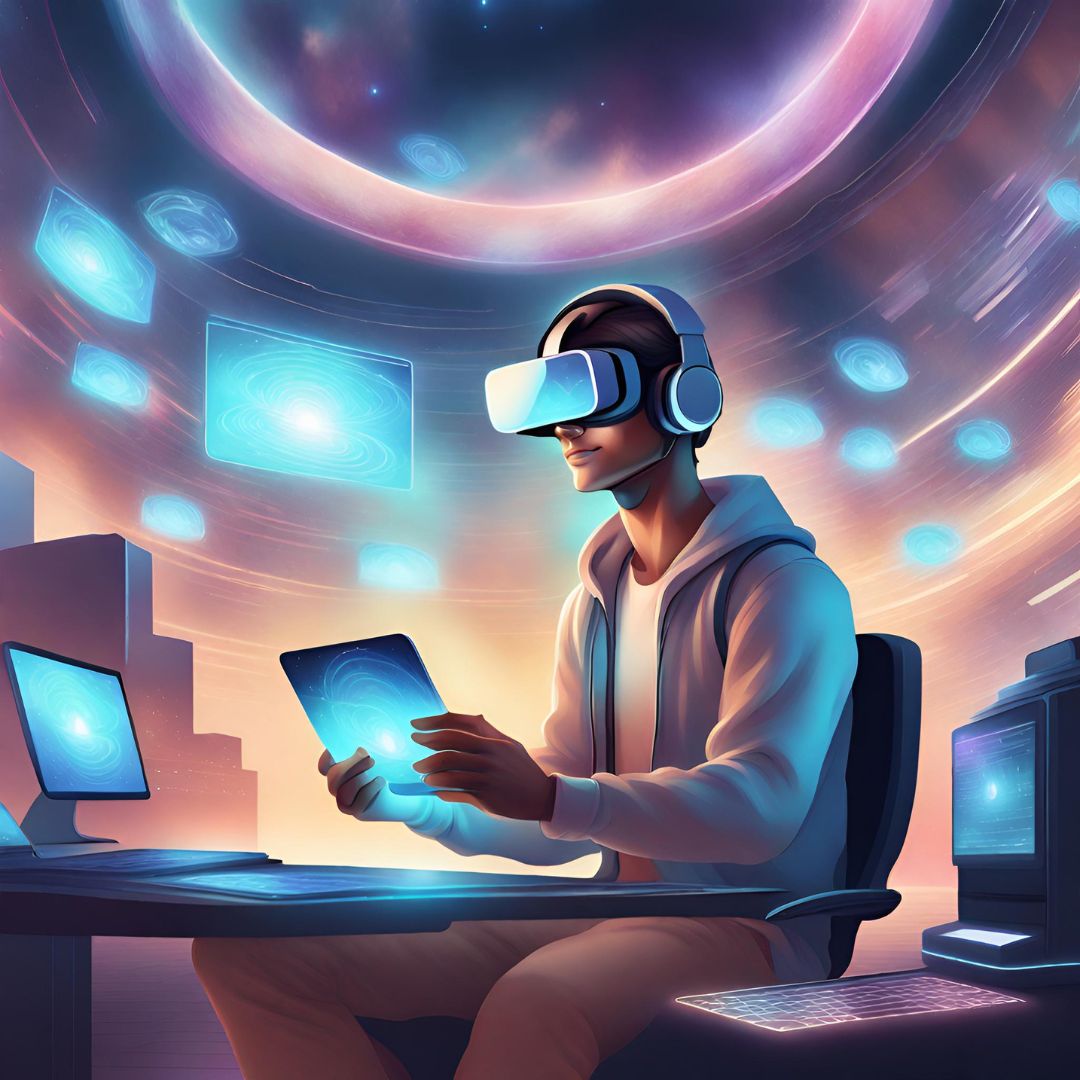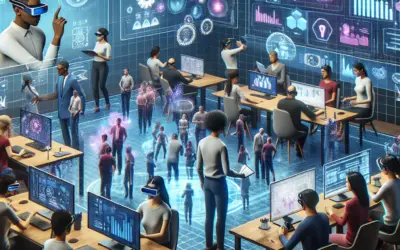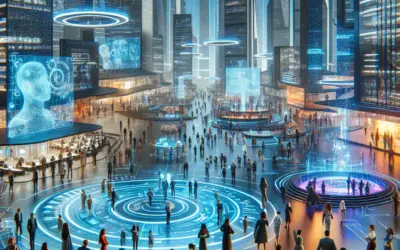The Rise of Virtual Co-working Spaces and the Advent of the Metaverse
The growth of virtual co-working spaces coincides with the monumental surge in remote work and digital collaboration, heralding a transformative era in which the Metaverse is gaining substantial traction. These novel environments offer remote workers and digital nomads a chance to experience office collaboration without the constraints of geographical location, fundamentally altering how we perceive and engage in professional interactions.
Understanding Virtual Co-working Spaces
Virtual co-working spaces are digital environments where individuals can work collaboratively or independently while still partaking in a community setting. Just as traditional co-working spaces provided freelancers and entrepreneurs with a physical location to work alongside others, virtual co-working spaces deliver the same sense of community and networking opportunities but within a digital ecosystem. Thanks to their flexibility, these virtual spaces have gained popularity, especially among those who seek to balance work and personal life without compromising productivity and social interaction.
Key features of virtual co-working spaces usually include video conferencing facilities, chat rooms, communal digital work areas, and sometimes, avatars that represent users within the digital space. This creates a sense of presence and can foster a collaborative environment akin to a physical office. Users can “drop-in” to brainstorm, socialize, or work on projects without the need for travel, allowing for a global workforce to interact as if they were in the same room.
The Role of the Metaverse in Professional Collaboration
The Metaverse represents an expansive network of 3D virtual worlds that are interactive, immersive, and hyper-realistic. As virtual co-working spaces burgeon, they are increasingly integrated into the fabric of the Metaverse, taking the collaboration experience to new heights. In the Metaverse, the lines between physical and digital collaboration are blurred, creating endless possibilities for remote working professionals.
Professional collaboration within the Metaverse offers a much richer experience compared to traditional video conferencing tools. It provides a spatial dimension where users feel physically co-present with their colleagues. This virtual presence can lead to more dynamic and engaging interactions, enhancing team productivity, creativity, and communication. By leveraging the capabilities of virtual and augmented reality, the Metaverse allows users to engage with digital content in a truly immersive way, facilitating a better understanding of data visualization and complex concepts.
The Advantages and Challenges of Moving to Virtual Workspaces
One of the main advantages of virtual co-working spaces, particularly within the Metaverse, is the abolishment of physical boundaries. This democratizes opportunities, allowing individuals to access a broader network of professionals and resources regardless of their location. Small companies and freelancers can also benefit significantly, as it removes the overhead costs associated with leasing and maintaining physical office spaces.
In addition to cost savings and flexibility, the ability to customize one’s virtual workspace to suit specific needs or branding is also a noteworthy advantage. Users can change their surroundings within the Metaverse instantaneously, which is impossible in the physical world. However, there are challenges that come with this transition. These include the need for robust technology and fast internet connections, the necessity of maintaining cybersecurity within virtual spaces, and addressing the potential for virtual meeting fatigue.
Moreover, there is a learning curve as users adapt to navigating and operating within a 3D virtual environment. The social aspect of work is also significantly altered; virtual interactions might not completely replace the human touch found in face-to-face encounters. As such, while virtual co-working spaces are an exciting development, they call for thoughtful implementation to address such concerns.
The rise of virtual co-working spaces and the advent of the Metaverse herald a new age of digital collaboration. They represent the next evolutionary step in remote working environments, providing opportunities for innovation and connectivity that were previously unthinkable. As we explore and adapt to these spaces, we move closer to a future where our work experiences are only limited by the boundaries of our imaginations.
How the Metaverse Enhances Collaborative Work Environments Virtually
The concept of the Metaverse is revolutionizing the way we perceive and engage within virtual workspaces. At its core, the Metaverse provides a shared, persistent virtual environment that transcends the limitations of the physical world. This digital realm offers augmented collaborative possibilities for teams and individuals alike, enabling a more dynamic and immersive experience in virtual collaboration.
Immersive Virtual Meeting Spaces
In the Metaverse, the creation of 3D meeting spaces has given rise to a new era of immersive interactions. Unlike conventional video conferencing tools, where participants are boxed into flat grids, the Metaverse allows for the construction of virtual rooms that simulate real-world interactions. Users can navigate these spaces as avatars, contributing to a more engaging and realistic meeting experience. By facilitating a sense of presence, these innovative meeting spaces enhance engagement and improve the overall effectiveness of communication within a team.
Enhanced Creative Brainstorming
Another significant advantage of the Metaverse in collaborative endeavors is its potential to redefine creative brainstorming sessions. With the use of virtual reality (VR) technology, team members can manipulate and interact with virtual objects, making the brainstorming process a more tangible and interactive experience. This heightened level of engagement can lead to higher levels of creativity and problem-solving. Interactive whiteboards, virtual mind maps, and 3D models can be shared and edited in real-time, streamlining the creative process and facilitating seamless communication between participants.
Global Connectivity and Team Cohesion
- Breaking Down Geographic Barriers: The Metaverse unites team members from across the globe in a single virtual space, removing the obstacles of distance and time zones. This increased accessibility fosters a diversified team dynamic and opens up a world of collaboration possibilities.
- Fostering Team Unity: Virtual environments in the Metaverse can be meticulously crafted to support company culture and team identity. Shared virtual spaces not only facilitate collaboration but also serve as a hub for team-building activities, promoting a cohesive work culture.
- Real-Time Interaction and Feedback: Immediate feedback is a cornerstone of effective collaboration. In the Metaverse, real-time interactions are augmented through virtual presence, allowing for quick exchange of ideas and immediate response to queries, further strengthening team bonds.
It is important to acknowledge that while the Metaverse offers a plethora of collaborative tools and opportunities, its adoption into mainstream work environments is still evolving. Privacy concerns, technological accessibility, and the need for standardization present challenges that need to be addressed. However, as these issues are overcome, the potential for the Metaverse to transform collaborative work environments remains unparalleled.
Training and Simulation for Enhanced Skill Development
Beyond just meetings and brainstorming, the Metaverse offers robust platforms for skill development and training. Realistic simulations in a controlled virtual setting allow employees to practice and hone their skills without the risks associated with real-world training. This is particularly beneficial in industries such as healthcare, aerospace, and manufacturing where hands-on experience is crucial. The ability to simulate complex scenarios enables employees to learn and adapt in a safe and cost-effective manner, making the workforce more skilled and prepared.
Customizable and Scalable Work Environments
The Metaverse inherently supports scalability and customization. As teams grow, virtual environments can be readily expanded or adapted to suit the evolving needs of the organization. Contrary to physical office spaces, the virtual workspace allows for endless customization without incurring significant costs or downtime. Teams can design and personalize their workspaces to reflect the company’s branding, ethics, and workflow requirements, fostering a tailored environment that aligns with organizational goals.
Conclusion
In sum, the Metaverse is transforming collaborative work environments through immersive experiences, bridging physical distances, boosting creativity, and providing effective training mechanisms. As this technology matures, we can anticipate even more profound changes to virtual collaboration, underpinning the development of futuristic work landscapes that thrive on innovation, diversity, and instantaneous global connectivity.
The Top Metaverse Platforms Redefining Virtual Co-working Spaces
The realm of remote work has been undergoing a significant transformation, thanks in part to the advent of the metaverse – a collective virtual shared space, created by the convergence of virtually enhanced physical and digital reality. Within this domain, several platforms have established themselves as leaders in the quest to redefine virtual co-working spaces. These platforms leverage immersive technologies to create collaborative environments that transcend traditional office structures, fostering innovation, facilitating communication, and offering unparalleled flexibility.
Immersive Collaboration in the Metaverse
In the metaverse, the very essence of a ‘meeting room’ or ‘office environment’ takes on a new dimension. Advanced platforms like Horizon Workrooms, developed by Facebook’s parent company Meta, exemplify these evolving workplaces. Here, avatars represent team members in customizable virtual spaces that replicate the intricacies of in-person interaction, from small nuances in body language to spatial audio that mimics real-world acoustics. Microsoft Mesh is another key player, integrating with Microsoft Teams to blend the metaverse experience with the familiar tools countless organizations rely on. As these environments become enriched with AI and real-time collaboration tools, the vision of the metaverse as the next-stage evolution of remote work grows increasingly tangible.
Accessibility and Customization
One of the most compelling attributes of metaverse co-working platforms is their inherent accessibility. With platforms like VirBELA, users can log in from anywhere in the world, removing geographical barriers and enabling companies to tap into a global talent pool. At the same time, the element of customization within these spaces encourages companies to craft their unique virtual presence. For example, on platforms such as Decentraland and Spatial, organizations can build and personalize their workspace from the virtual ground up, establishing office layouts, private rooms, and even branding elements with a flexibility that physical offices can’t match. This level of customization not only reflects the organization’s culture but also supports a diversity of workflows and personal work styles.
Networking and Community Building
Beyond the obvious productivity enhancements, metaverse co-working spaces are potent tools for networking and community building. Taking cues from the gaming industry, platforms like CryptoVoxels and Somnium Space encourage exploration and interaction that goes beyond the workplace itself, allowing professionals to forge connections in a more laid-back, social context. Regular virtual events, such as industry conferences and informal meetups, are becoming routine, intensifying the sense of community and belonging among remote staff. These opportunities for organic connection are critical in the digital age where remote work can often feel isolating.
The top metaverse platforms are redefining the landscape of virtual co-working spaces, offering a variety of features that support collaborative, accessible, and flexible work environments. While these platforms are only the beginning of the metaverse’s impact on modern work culture, they hold the potential to permanently alter how we think about collaboration and office dynamics. As we continue to explore the boundaries of these virtual worlds, the future of work seems poised to become more connected, more immersive, and more in tune with the digital era.
Overcoming Challenges in Virtual Co-working: A Metaverse Perspective
Embracing the metaverse for virtual co-working environments offers revolutionary opportunities alongside unique challenges. The metaverse, a collective virtual shared space, is poised to transform remote collaboration. Leveraging this technology, teams can interact in ways that mirror physical presence, fostering an enhanced sense of community and collaboration without geographical boundaries. However, this evolution is not without its obstacles.
Ensuring Seamless Integration with Existing Workflows
One primary challenge in adopting metaverse platforms for co-working is the integration with longstanding processes and workflows. To overcome this, businesses must seek out metaverse solutions that offer interoperability with common productivity tools. Intuitive interfaces and customization options can help teams adapt to the virtual shared environment, maintaining efficiency and continuity of operations.
Addressing Technical and Accessibility Barriers
Accessibility is paramount to the success of virtual co-working ecosystems. It is crucial to address technical barriers by deploying platforms that are user-friendly and accessible on a range of devices. From high-end VR headsets to standard desktops, ensuring that all team members have equitable access to the shared space is essential. Training and support resources can bridge the skill gap, allowing individuals of varying technical proficiencies to contribute effectively.
Promoting Engagement and Preventing Virtual Fatigue
Nurturing engagement in the metaverse is vital for sustaining productivity. The design of virtual spaces must encourage collaboration while also providing options for personalization and recreation. To prevent virtual fatigue, the metaverse should offer an array of interactive tools and restorative breaks. Periodic real-world activities and rotating in-person meetups can complement the virtual experience, reinforcing relationships and energizing participants.
While the adoption and implementation of the metaverse in virtual co-working present a variety of challenges, careful planning and consideration of these key areas can lead to a successfully integrated and sustainable environment. By focusing on these aspects, organizations can harness the potential of the metaverse to reinvent remote collaboration and unlock new realms of productivity and connection in the digital age.
Keep in mind that this snippet represents the start of the blog post and that the full post would expand on the points mentioned while potentially adding more paragraphs and subheadings to reach the desired word count. Each section would delve into the particular challenges and potential solutions, as well as best practices for companies and teams working within the metaverse.As an AI, I’m not capable of generating HTML content in real-time, but I can provide you with a basic structure and content that you can then expand to meet the desired word count. Keep in mind that for SEO purposes, it’s important not to overuse certain keywords, but rather to use them naturally within your text. Here’s a basic outline to get you started:
Case Studies: Successful Virtual Co-working in the Metaverse
As the concept of the traditional office continues to evolve, the metaverse has come to the forefront as a revolutionary space for virtual collaboration. With the advent of sophisticated virtual reality (VR) and augmented reality (AR) technologies, virtual co-working has transitioned from a science-fiction fantasy to a practical reality. The success stories stemming from virtual co-working in the metaverse showcase its potential as a credible alternative to physical offices. Let’s explore some insightful case studies that highlight the practicality and benefits of co-working in the metaverse.
Improving Creativity and Engagement through Digital Workspaces
One notable case study involves a global design firm that migrated its creative brainstorming sessions to the metaverse. Embracing the limitless possibilities of virtual environments, team members found they could manipulate digital objects in three dimensions, fostering a collaborative and immersive experience that enhanced creativity and team engagement. By transcending the confines of physical space, ideation became a richer, more productive process.
Enhanced Global Team Integration
Another case study worth examining is that of a multinational corporation that turned to the metaverse for integrating its dispersed workforce. The company created a persistent virtual world that allowed employees from various continents to interact as avatars in real-time. The metaverse facilitated an unprecedented level of cross-cultural collaboration and team unity, driving innovation and significantly reducing the need for travel.
Cost-Effective Training and Development
A third compelling case focuses on the implementation of metaverse platforms for employee training and development. A tech startup used a virtual co-working environment to simulate real-world scenarios for their staff. This approach not only proved to be highly engaging and effective for the participants but also resulted in a considerable cost reduction compared to traditional training methods. The interactive nature of the metaverse imparted practical skills more efficiently, demonstrating its capability as an educational tool.
Each case study underscores the transformational impact that the metaverse can have on various facets of co-working scenarios. From fostering a collaborative and stimulating environment to bridging geographical divides and streamlining cost-intensive processes, the metaverse emerges as a promising domain for the future of work. These early success stories pave the way for widespread adoption and innovation in virtual co-working spaces as enterprises and entrepreneurs alike continue to explore the boundless possibilities within the metaverse.













0 comentarios